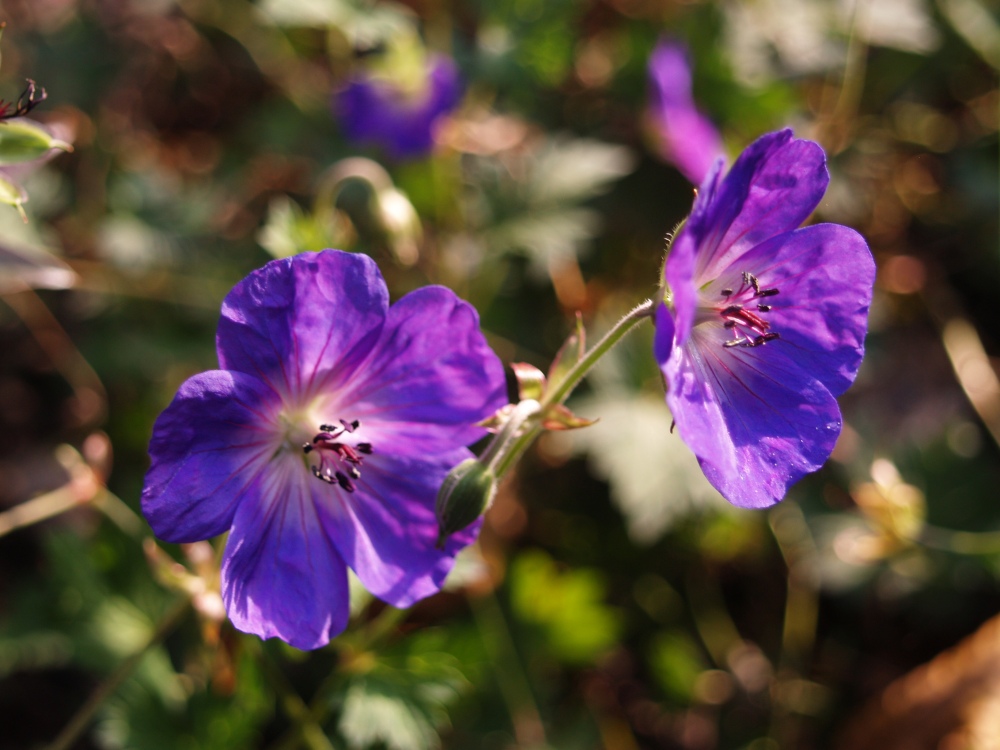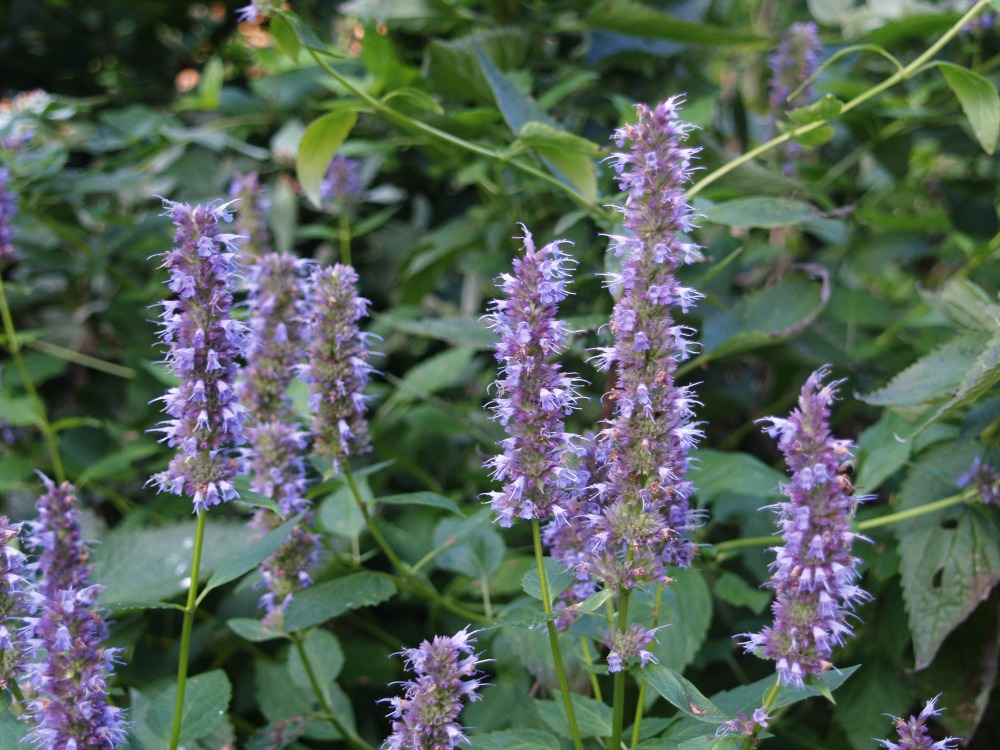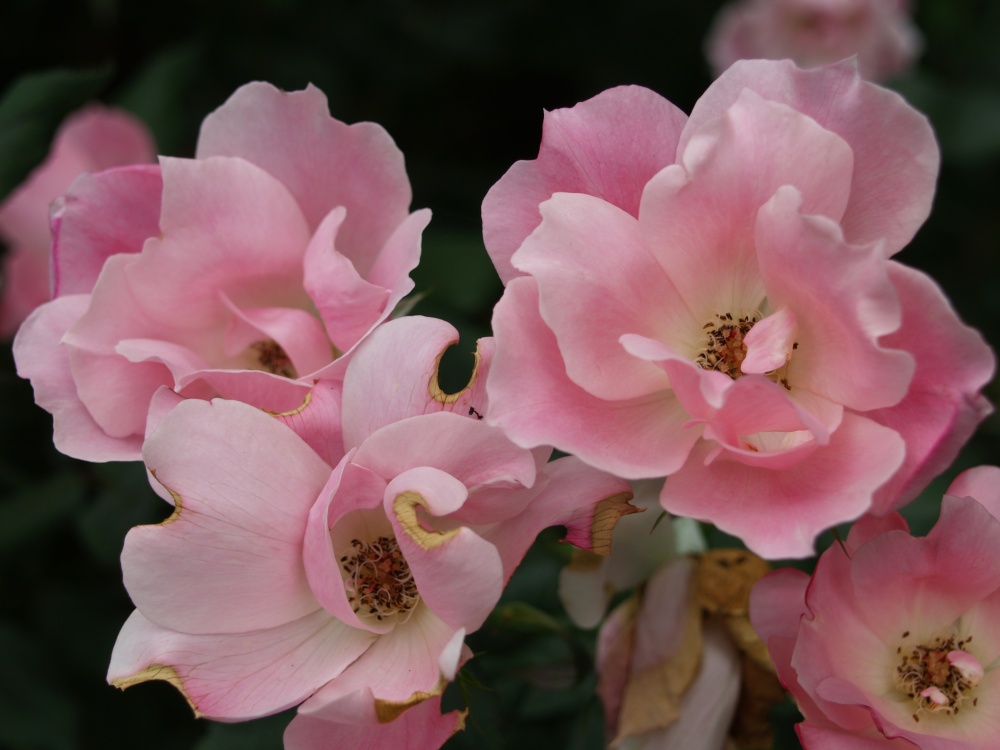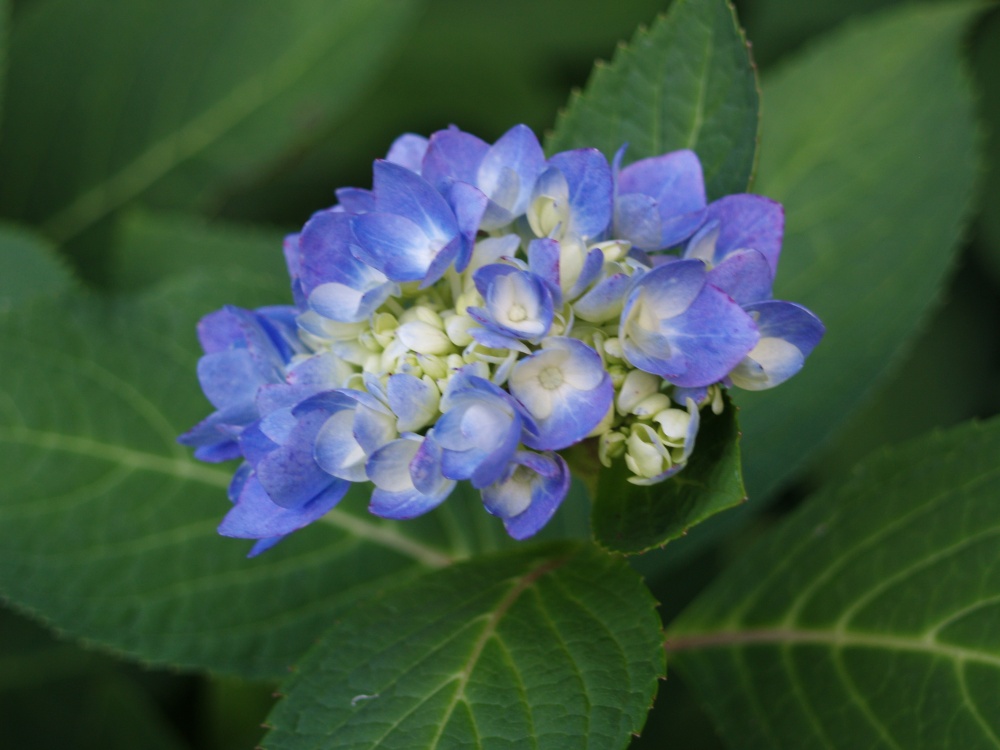Several of the crapemyrtles in the garden have become more shaded by taller neighbors through the years so that they begin to flower several weeks later than in nearby sunny gardens. This year there were only a few scattered blooms on Natchez in late June, and the normally later flowering Sioux began to bloom only a few days later. By whatever peculiarity (but likely due to the abnormally wet and cloudy weather since the middle of August), Sioux remains in bloom in early October, the latest that I can recall. If we suppose that the start of July was the first significant bloom, Sioux will have been flowering for ninety days, and counting. Perhaps, this is not unusual for deeper in the south, but in northwestern Virginia I don’t recall a longer blooming season.
A number of perennial geraniums flower over long periods, but of the handful in my garden ‘Rozanne’ (below) blooms from late May until a hard frost in October. I’ve had some problems establishing ‘Rozanne’ in the garden in past years, but in an area with consistently moist soil it has grown splendidly for the past few years. It bloomed through summer without any evidence of heat related decline, and only with repeated night time temperatures in the low forties has it slowed down.
Other perennials will rebloom if deadheaded, but I am either traveling or too lazy for much summer garden work, so I cut perennials back only occasionally. I’ve found that hummingbird mints are the most dependable reblooming perennials without any care at all.
Older stems of ‘Blue Fortune’ (Agastache ‘Blue Fortune’, above) are covered with spent blooms, and though most stems remain stiffly upright, some arch after the recent heavy rains. Abundant new flowering stems are not as tall, but bees have no trouble finding them, and this hummingbird mint has been in constant bloom since at least June.
The reblooming hydrangeas displayed a few more flowers this summer than the one before, despite the few weeks when temperatures averaged nearly one hundred degrees. Last year the heat was more prolonged, and I’ve seen that hydrangeas produce fewer buds in the heat (and dryness) of summer. With cooler temperatures and abundant rainfall the shrubs are covered with buds, though many of these will not develop into flowers before the first frost.
I’ve found that the best reblooming hydrangeas are Penny Mac (above) and Endless Summer, both of which are blue in the acidic clay soil of my garden. The more compact growing Mini Penny does not have a single bud, nor do the white Blushing Bride and lacecap Twist N’Shout. Perhaps these would flower again if they were cut back after blooming, but Penny Mac and Endless Summer flower through the summer and early autumn without any attention on my part. 
Over the past several years I have planted a number of shrub and ground cover roses, all the low care, reblooming sorts that have become so popular. Knockout roses (Knockout Red, above) are most commonly known, and these continue to perform well without requiring treatments for fungus or insects. They flower intermittently from May into November in this area, and though the rebloom is not as heavy as the first of the season, there is rarely a period when these roses aren’t showing some color.
In my garden the pink Knockout flowers over a longer period, and with more abundant blooms than any of the others, but I prefer the cherry red to the light pink and the darker foliage of the red is more attractive.
If temperatures don’t dip too low the reblooming Boomerang lilac (Syringa x ‘Boomerang’) will flower for the last time this year in mid October. The lilac requires pruning to set new buds, and as a newly planted small shrub I’ve been able to keep up. I expect that as it grows larger I’ll fall behind, and in a few years I’m likely to be disappointed that it is just another lilac without deadheading.
In this garden the rebloomers are greatly appreciated for their consistent color, and a few are appropriate for a garden of any size. But, flowers that last for a month, a week, or even for only a few days to interrupt the day after day sameness should not be ignored, and the garden is not complete without some of each.

Hi Dave,
I am not sure what Sioux is?
I have crepe Myrtles and some are still blooming… They both were a cutting from a friends tree and ended up one dark pink with dark foliage and one the light pink that is like the tree it was rooted from…
Knock out roses are beautiful. I have the red dark foliage that always does well and I have a yellow one that I will be moving and amending soil for the third time this November because it never does well, ever.
My hydrangeas only bloomed once this year since I trimmed them when I think that I wasn’t supposed to and I am not sure when they are to be trimmed? Are you supposed to cut off the spent blooms or not? I have an endless summer, oak leaf and lace cap and they are all huge and love the spot they are in as they only get morning sun…
Have a great day!
Sioux crapemyrtle has dark green foliage and exceptional autumn color. In my garden the yellow Knockout rose has not impressed, but it gets less than full sun, so I’ve taken the blame for its mediocre performance. With the quantity of small trees that I’ve planted (that are no longer so small) I’m afraid that my rose days are numbered, and several of the Drift roses have drifted beneath wide spreading neighbors so that this is likely to be their last gasp.
With reblooming hydrangeas the timing of pruning doesn’t matter, but with most mopheads the buds for flowers for the following year form immediately after blooming, so it is practically impossible to prune without damaging flowers. The best bet is to prune select branches rather than the entire shrub so that only some buds are removed.
My yellow knockout has always been in full sun, so after this third move I will let you know… I have had other people inform me that the yellow has never done well. My red is a double knockout and the yellow is a single so maybe that has something to do with it.
Okay I understand about the hydrangeas now because I really hacked at them because they were huge! I will be more careful next time. Thanks for that information and I guess my American Smoke Tree is now on its way to me :o)
I planted two red knockout roses in the spring and they are doing great! They grew from 2 feet tall to almost 4 or 5 feet tall in 6 months. My question is should I prune these back to a smaller size so the branches don’t all fall over from the winter snow that we get in Northern Virginia or should I leave them as is and prune them back in early spring?
I planted three Knockout roses ten feet from the street where I figured that they would be back far enough that I could pull out of the drive without them blocking my view. I didn’t consider piles of snow from plows at all, but one of three was damaged from under a six foot mound of compacted snow.
Of course this was unusual. A snowplow that couldn’t tell road from front yard in the deep snow ventured thirty feet into the grass, stopping within feet of the trunk of the large purple leafed beech. Roses in other parts of the garden were unharmed by the heavy snow.
Under most circumstances there is no need to fear for your roses going into winter. The best time to prune is in early March, though there is little harm in late autumn pruning. In any case pruning should not be done until it is certain that the roses are fully dormant. I’ve had Knockouts blooming the week of Thanksgiving, so early December is likely to be the safe date.